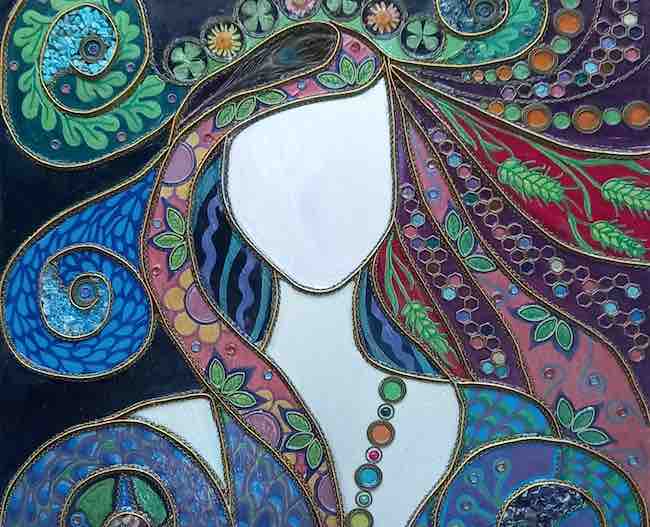La tendenza a osservare l’equilibrio estetico inteso come connessione tra forma esteriore e intensità dell’aprirsi alla bellezza straordinaria del quotidiano, sembra aver perduto la sua importanza in un mondo creativo contemporaneo dove la priorità è quella di osservare, contestare, opporsi alla realtà del vivere oppure, al contrario, rinunciare a qualsiasi attinenza con l’osservato per tendere verso le inquietudini o le sensazioni più profonde che poco spazio lasciano al gusto verso l’armonia figurativa. Tuttavia esistono alcuni artisti, originali e coraggiosi, che scelgono di portare avanti alcune tematiche teorizzate nel secolo scorso adeguandole alla propria personalità espressiva e introducendo le innovazioni dei movimenti successivi allo stile prescelto ma precedenti al proprio inizio creativo. La protagonista di oggi sceglie di compiere un balzo indietro nel tempo attraverso un linguaggio personale che riconduce a una fase artistica che ha segnato un passaggio importante nel mondo culturale del recente passato.
Tra la fine dell’Ottocento e gli inizi del Novecento la società europea stava assistendo a una forte industrializzazione dunque una tendenza ad andare verso un appiattimento delle caratteristiche del singolo così come verso nuove tecnologie di riproduzione in serie che rischiavano di togliere umanità all’uomo e di fatto allo stesso artigiano che fino a qualche anno prima non doveva competere con macchinari in grado di fare più velocemente il suo lavoro. Così in Inghilterra nacque l’Arts and Crafts un movimento artistico che si proponeva di fondere in un unico stile l’arte e l’artigianato, elevando il secondo a creazione di primo livello proteggendolo così dal rischio di essere surclassato dalla meccanizzazione, e ampliando le possibilità della prima concedendo agli esecutori delle opere l’opportunità di apprendere tecniche nuove con cui arricchire e dare un tocco unico a creazioni in cui il gusto estetico e l’armonia delle forme era talmente presente da diventare un segno distintivo. Le linee guida dell’Arts and Crafts divennero una vera e propria corrente pittorica qualche anno dopo, inizialmente in Belgio e poi in tutte le nazioni europee dove la sua evoluzione assunse un nome differente a seconda del paese di provenienza degli artisti: Art Nouveau in Francia, Jugendstijl in Germania, Sezessionstijl in Austria, Stile Liberty in Italia e Modernismo in Spagna, solo alcune delle definizioni date al nuovo approccio artistico contraddistinto da una forte inclinazione decorativa, su base floreale perché ispirata alla natura ma arricchita da foglia oro, come nelle straordinarie tele di Gustav Klimt, dalla presenza di affascinanti e innocenti donne come nelle eteree opere di Alfons Mucha, dalle visioni architettoniche di Antoni Gaudì alle vetrate ornamentali e sinuose di Victor Horta. Di fatto l’Art Nouveau toccò anche l’arredamento di interni, le creazioni in vetro, la gioielleria, gettando le basi per l’immediatamente successiva Art Deco che si pregiò di un approccio più teso verso il lusso, lo sfarzo, forse per celebrare in qualche modo la fine del primo periodo bellico che tanta distruzione aveva prodotto. Anche in quest’ultimo la caratteristica era quella di diffondersi divenendo dunque uno stile multidisciplinare allo stesso modo di come lo era stata la precedente Art Nouveau. Tanto poliedrico l’approccio creativo dei maestri del passato a cui si ispira quanto lo è quello dell’artista francese Valérie Arvalys che racchiude in sé lo spirito originario dell’Art Nouveau, quello di estendere l’arte a varie forme espressive, a differenti materiali su cui infondere il proprio tocco elegante e raffinato, introducendo però un concetto nuovo, quello dell’elemento materico che sarebbe stato sperimentato qualche decennio soprattutto con l’Arte Informale.
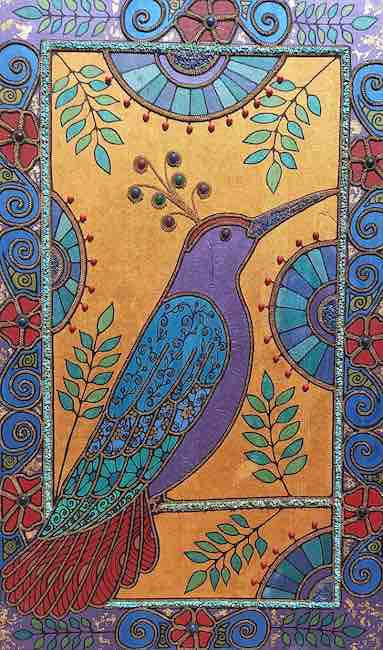
Ma la Arvalys attinge anche all’Art Deco, per la sua attrazione verso il glamour, lo scintillio del bel vivere, per l’eleganza voluttuosa di cui fu grande interprete e indiscussa regina Tamara de Lempicka, e per l’incontestabile cristallina malia riscontrabile nell’architettura di cui si hanno maestosi esempi in particolar modo nei grattacieli statunitensi; le opere dell’artista francese sono contraddistinte dal fasto delle superfici arricchite da pietre che divengono parte integrante della tela, tanto quanto dall’utilizzo di tessuti e fili che sembrano veri e propri ricami i quali si affiancano allo sguardo verso la natura che svela la delicatezza sensibile dell’artista, quella spontaneità con cui guida l’osservatore verso un universo equilibrato, poetico e armonioso nella sua disarmante bellezza.
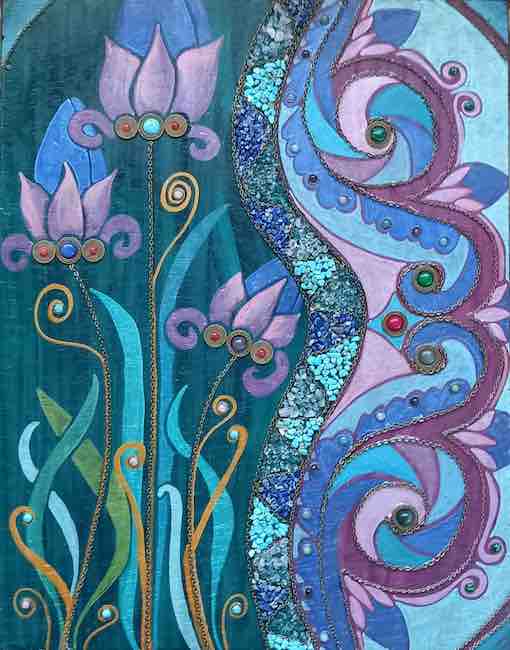
Ciò che è alla base dell’arte di Valérie Arvalys è la ricerca che si spinge oltre la bidimensionalità dell’immagine, perché la sontuosità e l’eleganza delle sue opere, frutto di quella mescolanza tra la regalità dell’Art Deco e la ricchezza floreale e faunistica dell’Art Nouveau, ha bisogno di essere ancor più evidenziata in virtù dell’interazione con la materia, come se dovesse essere sottolineata dalla ruvidità degli inserti di metalli, di strass, di pietre e di perle incastonate allo stesso modo dei gioielli, di fiori secchi, piume, tessuti, pelle e argilla, e in grado di avvolgere di atmosfera retro le sue creazioni artistiche.
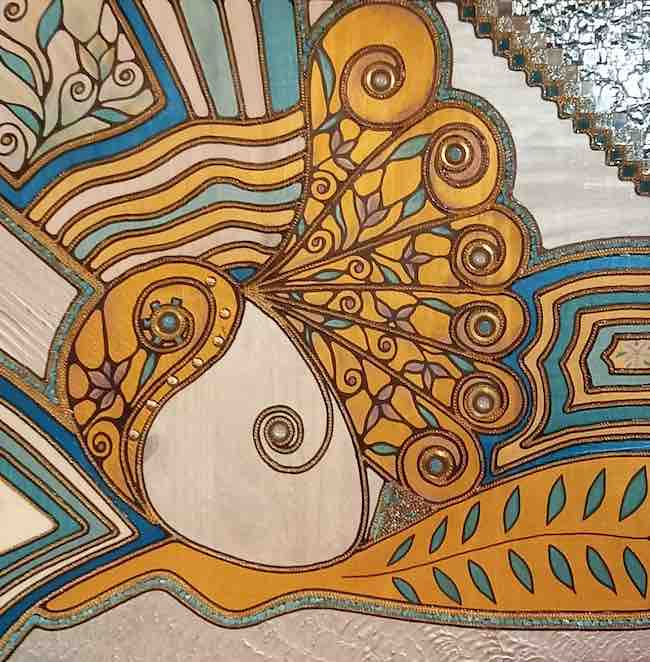
La natura dunque diviene mondo ammaliante da scoprire con uno sguardo diverso, con quell’approccio estetico che ha caratterizzato lo stile lussuoso dei primi anni del Novecento e che è ancora in grado di affascinare l’osservatore inducendolo a immaginare un’epoca passata in cui tutto sembrava essere meno complicato della contemporaneità. Il carattere curioso della Arvalys la spinge a misurarsi non solo con molteplici materiali ma anche con superfici differenti, dal legno al vetro, dalla tela all’argilla, proprio per inseguire quell’idea, costituente la base dell’Art Nouveau, secondo cui l’artista poteva attingere alla manualità artigianale trasformando le tecniche per adattarle alla propria indole creativa.
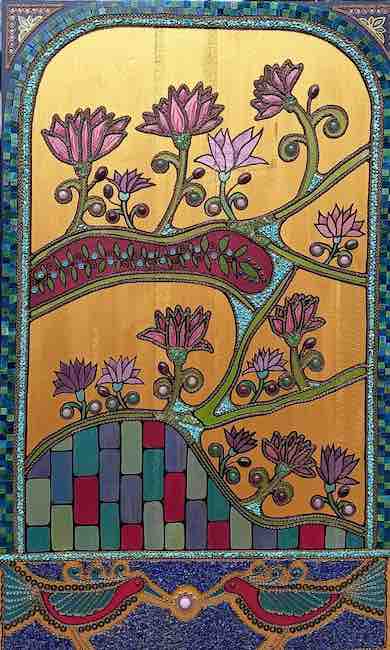
Il risultato è coinvolgente proprio perché induce l’osservatore a compiere un vero e proprio viaggio nel tempo, attratto dalla bellezza degli sfondi in foglia oro su cui si delineano e si accostano tonalità eleganti quanto irreali, come nell’opera Printemps, dove i fiori sono splendidi elementi decorativi resi protagonisti dell’incanto della natura, come se si mettessero in posa per dare un aspetto charmant a tutto ciò che ruota loro intorno, la base del terreno e gli steli da cui sbocciano; Valérie Arvalys ricama letteralmente i suoi lavori mescolando, come in questo caso, il colore acrilico con le pietre a forma di perle che strutturano le foglie, con la catena gioiello che definisce i contorni, con i sassolini turchesi con cui riempie il contorno della cornice così come le basi dei fiori. Tutto contribuisce a infondere nell’osservatore una sensazione di ricercatezza e di raffinatezza magnetiche che lo inducono ad avvicinarsi per scoprire i dettagli ma al tempo stesso di riallontanarsi per ammirare l’immagine di insieme.
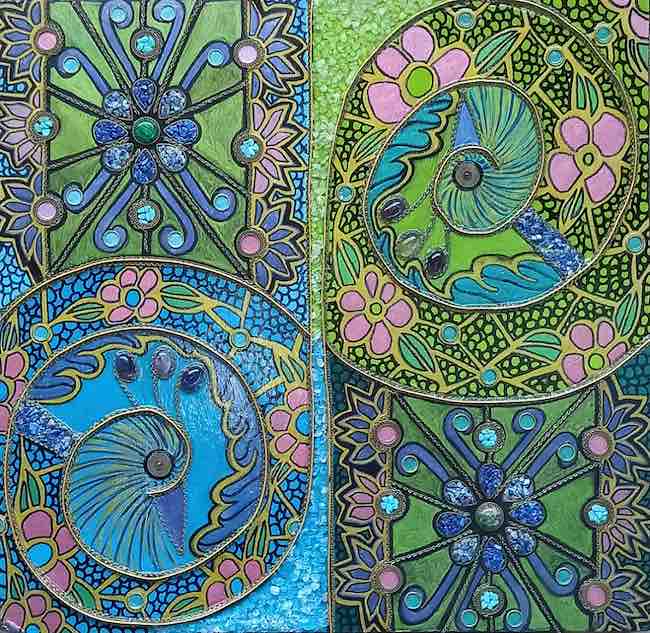
Nel lavoro Complicité l’artista si lascia ispirare dai colori del lago e della vegetazione dove abitualmente si trovano gli splendidi pavoni che rende protagonisti, avvolgendo e trasformando la realtà circostante con i magnifici colori del loro piumaggio; in quest’opera la Arvalys attinge all’idea dei multipli di Andy Warhol, quella caratteristica di suddividere la tela in quattro o più quadranti all’interno dei quali mettere in evidenza le sue iconiche dive degli anni Cinquanta, e la adatta alle proprie intenzioni artistiche modificandola, dividendo a sua volta lo spazio in quattro riquadri all’interno dei quali pone a due a due i soggetti, da un lato mettendo in evidenza l’opulenza che il pavone normalmente rappresenta e dall’altro affiancandogli la stilizzazione della ricchezza della vegetazione in cui lo splendido uccello si immerge e che sembra richiamarne le tonalità.
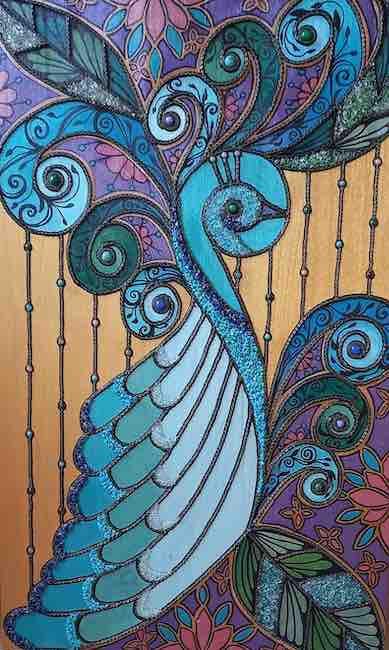
In Harpe Deco invece Valérie Arvalys mostra tutta la sua inclinazione verso l’equilibrio estetico, lo sfarzo che contraddistingueva lo stile pittorico e architettonico che è passato come una meteora lasciando però incredibili tracce di sé; l’arpa viene trasformata dall’artista in un sontuoso decoro che sembra associarsi alla magia delle note generate dalla strumento con cui le persone benestanti amavano intrattenersi.
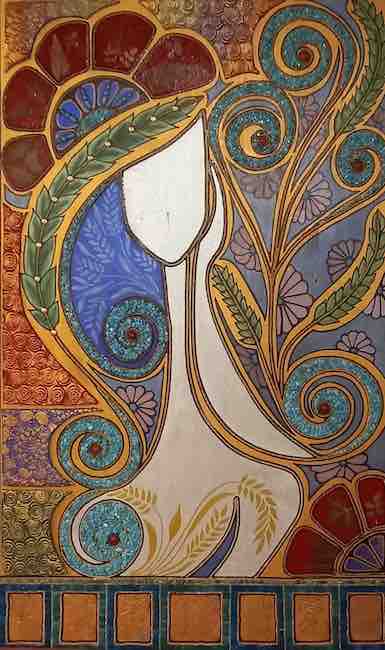
Bel vivere, fascino ed eleganza sono i tratti distintivi delle opere di Valérie Arvalys che ama misurarsi non solo con la pittura bensì anche con la fotografia e la poesia; figlia d’arte, il padre e il nonno erano pittori, ha al suo attivo la partecipazione a molte mostre collettive in Francia, tra cui Barbizon e il quartiere di Saint Germain a Parigi, e a fiere internazionali, riscuotendo successo sia tra il pubblico che tra gli addetti ai lavori. Recentemente ha ricevuto il Premio per la tecnica e per la qualità e la creatività delle sue opere all’ART Show Bastille Paris.
VALÉRIE ARVALYS-CONTATTI
Email: valerie.arvalys@gmail.com
Sito web: https://www.creations-arvalys-paris.fr/
Facebook: https://www.facebook.com/profile.php?id=100085190486986
Linkedin: https://www.linkedin.com/in/val%C3%A9rie-arvalys-aa86a9229/
Instagram: https://www.instagram.com/valeriearvalys/
The elegant Art Nouveau harmony of Valérie Arvalys’ artworks, where material meets refinement
The tendency to observe aesthetic balance, understood as the connection between exterior form and the intensity of opening oneself to the extraordinary beauty of the everyday, seems to have lost its importance in a contemporary creative world where the priority is to observe, to contest, to oppose the reality of living or, on the contrary, to renounce any connection with the observed in order to tend towards the restlessness or the deepest sensations that leave little room for taste towards figurative harmony. Nevertheless, there are some artists, original and courageous, who choose to pursue certain themes theorised in the last century by adapting them to their own expressive personality and introducing the innovations of movements subsequent to their chosen style but preceding their own creative beginnings. Today’s protagonist chooses to take a leap back in time through a personal language that brings to an artistic phase that marked an important passage in the cultural world of the recent past.
Between the end of the 19th century and the beginning of the 20th, European society was witnessing a strong industrialisation, thus a tendency to move towards a flattening of the characteristics of the individual as well as towards new technologies of mass reproduction that risked taking away humanity from man and in fact from the craftsman himself who until a few years before did not have to compete with machines capable of doing his work faster. This is how Arts and Crafts was born in England, an artistic movement that proposed to merge art and craftsmanship into a single style, elevating the latter to a first-rate creation, thus protecting it from the risk of being outclassed by mechanisation, and expanding the possibilities of the former by granting the executors of the artworks the opportunity to learn new techniques with which to enrich and give a unique touch to creations in which aesthetic taste and harmony of forms was so present as to become a distinctive mark. The Arts and Crafts guidelines became a true pictorial current a few years later, initially in Belgium and then in all European nations where its evolution took on a different name depending on the artists’ country of origin. Art Nouveau in France, Jugendstijl in Germany, Sezessionstijl in Austria, Stile Liberty in Italy and Modernism in Spain, were just some of the definitions given to the new artistic approach characterised by a strong decorative inclination, on a floral basis because inspired by nature but enriched with gold leaf, as in the extraordinary paintings of Gustav Klimt, by the presence of charming, innocent women as in the ethereal works of Alfons Mucha, by the architectural visions of Antoni Gaudí to the ornamental and sinuous stained glass windows of Victor Horta. In fact, Art Nouveau also touched on interior decoration, glass creations and jewellery, laying the foundations for the immediately following Art Deco, which prided itself on a more luxurious, opulent approach, perhaps to somehow celebrate the end of the first war period that had wrought so much destruction. In the latter, too, the characteristic was to spread, thus becoming a multi-disciplinary style in the same way as the earlier Art Nouveau had been.
Just as multifaceted is the creative approach of the masters of the past from which she is inspired as that of the French artist Valérie Arvalys, who encapsulates the original spirit of Art Nouveau, that of extending art to various forms of expression, to different materials on which to infuse an elegant and refined touch, introducing however a new concept, that of the material element that would be experimented a few decades later especially with Informal Art. But Arvalys also drew on Art Deco, for hers attraction to glamour, the sparkle of fine living, for the voluptuous elegance of which Tamara de Lempicka was a great interpreter and undisputed queen, and for the unquestionable crystalline malia noticeable in the architecture of which there are majestic examples, particularly in the American skyscrapers; the French artist’s artworks are characterised by the splendour of the surfaces enriched with stones that become an integral part of the canvas, as much as by the use of fabrics and threads that look like real embroidery, which flank the gaze towards nature that reveals the sensitive delicacy of the artist, that spontaneity with which she guides the observer towards a universe that is balanced, poetic and harmonious in its disarming beauty. What lies at the heart of Valérie Arvalys’ art is the research that goes beyond the two-dimensionality of the image, because the sumptuousness and elegance of her works, the result of that mixture between the royalty of Art Deco and the floral and faunal richness of Art Nouveau, needs to be even more emphasised by virtue of the interaction with matter, as if it were to be underlined by the roughness of the inserts of metals, rhinestones, stones and pearls set in the same way as jewellery, dried flowers, feathers, fabrics, leather and clay, and able to envelop her artistic creations in a retro atmosphere. Nature thus becomes a bewitching world to be discovered with a different gaze, with that aesthetic approach that characterised the luxurious style of the early 20th century and that is still able to fascinate the observer, leading him to imagine a bygone era when everything seemed to be less complicated than the present day.
Arvalys’ inquisitive nature drives her to measure herself not only with multiple materials but also with different surfaces, from wood to glass, from canvas to clay, precisely in pursuit of that idea, constituting the basis of Art Nouveau, according to which the artist could draw on manual craftsmanship by transforming techniques to adapt them to his own creative nature. The result is enthralling precisely because it takes the observer on a real journey through time, attracted by the beauty of the gold leaf backgrounds on which elegant yet unreal tones are outlined and juxtaposed, as in the artwork Printemps, where the flowers are splendid decorative elements made protagonists of the enchantment of nature, as if they were posing to give a charming aspect to everything that revolves around them, the base of the ground and the stems from which they bloom; Valérie Arvalys literally embroiders her artworks by mixing, as in this case, acrylic colour with the pearl-like stones that structure the leaves, with the jewelled chain that defines the contours, with the turquoise pebbles with which she fills the contours of the frame as well as the bases of the flowers. Everything contributes to instilling in the observer a feeling of sophistication and magnetic refinement that induces him to get closer to discover the details but at the same time to step back to admire the overall image. In the work Complicité, the artist is inspired by the colours of the lake and the vegetation where the splendid peacocks are usually to be found, making them the protagonists, enveloping and transforming the surrounding reality with the magnificent colours of their plumage; in this artwork, Arvalys draws on the idea of Andy Warhol’s multiples, that characteristic of dividing the canvas into four or more quadrants within which to highlight his iconic divas of the 1950s, and adapts it to her own artistic intentions by modifying it, in turn dividing the space into four quadrants within which she places her subjects two by two, on the one hand highlighting the opulence that the peacock normally represents, and on the other hand flanking it with a stylisation of the richness of the vegetation in which the splendid bird plunges and which seems to recall its hues.
In Harpe Deco, on the other hand, Valérie Arvalys shows all her inclination towards aesthetic balance, the magnificence that distinguished the pictorial and architectural style that passed like a meteor, leaving however incredible traces of itself; the harp is transformed by the artist into a sumptuous decoration that seems to associate itself with the magic of the notes generated by the instrument with which wealthy people loved to entertain themselves. Beautiful living, charm and elegance are the hallmarks of the works of Valérie Arvalys, who loves to measure herself not only with painting but also with photography and poetry; daughter of art, her father and grandfather were painters, she has taken part in many group exhibitions in France, including Barbizon and the Saint Germain district in Paris, and in international fairs, gaining success among both the public and the art world. She recently received the Award for Technique and for the quality and creativity of her works at the ART Show Bastille Paris.


